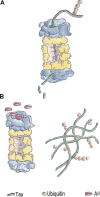The ubiquitin-proteasome system in Alzheimer's disease
- PMID: 18266959
- PMCID: PMC3822529
- DOI: 10.1111/j.1582-4934.2008.00276.x
The ubiquitin-proteasome system in Alzheimer's disease
Abstract
Accumulation of proteins is a recurring event in many neurodegenerative diseases, including Alzheimer's disease (AD). Evidence has suggested that protein accumulation may result from a dysfunction in the ubiquitin proteasome system (UPS). Indeed, there is clear genetic and biochemical evidence of an involvement of the ubiquitin proteasome system in AD. This review summarizes the data supporting an involvement of the UPS in the pathogenesis of AD, focusing on the data showing the relationship between Abeta and tau, the two hallmark lesions of AD, and the UPS.
Figures


Similar articles
-
Disrupted ubiquitin proteasome system underlying tau accumulation in Alzheimer's disease.Neurobiol Aging. 2021 Mar;99:79-85. doi: 10.1016/j.neurobiolaging.2020.11.015. Epub 2020 Dec 8. Neurobiol Aging. 2021. PMID: 33422896 Review.
-
Protein quality control in Alzheimer's disease by the ubiquitin proteasome system.Prog Neurobiol. 2004 Dec;74(5):249-70. doi: 10.1016/j.pneurobio.2004.10.001. Prog Neurobiol. 2004. PMID: 15582222 Review.
-
Relationship between amyloid-beta and the ubiquitin-proteasome system in Alzheimer's disease.Neurol Res. 2014 Mar;36(3):276-82. doi: 10.1179/1743132813Y.0000000288. Neurol Res. 2014. PMID: 24512022 Review.
-
The Ubiquitin System in Alzheimer's Disease.Adv Exp Med Biol. 2020;1233:195-221. doi: 10.1007/978-3-030-38266-7_8. Adv Exp Med Biol. 2020. PMID: 32274758 Review.
-
Endo-lysosomal pathway and ubiquitin-proteasome system dysfunction in Alzheimer's disease pathogenesis.Neurosci Lett. 2019 Jun 11;703:68-78. doi: 10.1016/j.neulet.2019.03.016. Epub 2019 Mar 16. Neurosci Lett. 2019. PMID: 30890471 Free PMC article. Review.
Cited by
-
Animal models of Alzheimer disease.Cold Spring Harb Perspect Med. 2012 Nov 1;2(11):a006320. doi: 10.1101/cshperspect.a006320. Cold Spring Harb Perspect Med. 2012. PMID: 23002015 Free PMC article. Review.
-
Contributions of brain insulin resistance and deficiency in amyloid-related neurodegeneration in Alzheimer's disease.Drugs. 2012 Jan 1;72(1):49-66. doi: 10.2165/11597760-000000000-00000. Drugs. 2012. PMID: 22191795 Free PMC article. Review.
-
The role of mTOR signaling in Alzheimer disease.Front Biosci (Schol Ed). 2012 Jan 1;4(3):941-52. doi: 10.2741/s310. Front Biosci (Schol Ed). 2012. PMID: 22202101 Free PMC article. Review.
-
Recent advances in our understanding of neurodegeneration.J Neural Transm (Vienna). 2009 Sep;116(9):1111-62. doi: 10.1007/s00702-009-0240-y. Epub 2009 Jun 5. J Neural Transm (Vienna). 2009. PMID: 19707851 Review.
-
Ubiquitin carboxyl-terminal esterase L1 (UCHL1) S18Y polymorphism in patients with cataracts.Ophthalmic Genet. 2011 Jun;32(2):75-9. doi: 10.3109/13816810.2010.544360. Epub 2011 Jan 26. Ophthalmic Genet. 2011. PMID: 21268678 Free PMC article.
References
-
- Lambon Ralph MA, Patterson K, Graham N, Dawson K, Hodges JR. Homogeneity and heterogeneity in mild cognitive impairment and Alzheimer's disease:a crosssectional and longitudinal study of 55 cases. Brain. 2003;126:2350–62. - PubMed
-
- Welsh KA, Butters N, Hughes JP, Mohs RC, Heyman A. Detection and staging of dementia in Alzheimer's disease. Use of the neuropsychological measures developed for the Consortium to Establish a Registry for Alzheimer's Disease. Arch Neurol. 1992;49:448–52. - PubMed
-
- Artero S, Tierney MC, Touchon J, Ritchie K. Prediction of transition from cognitive impairment to senile dementia: a prospective, longitudinal study. Acta Psychiatr Scand. 2003;107:390–3. - PubMed
-
- Perry RJ, Hodges JR. Attention and executive deficits in Alzheimer's disease. A critical review. Brain. 1999;122:383–404. - PubMed
Publication types
MeSH terms
Substances
Grants and funding
LinkOut - more resources
Full Text Sources
Other Literature Sources
Medical

